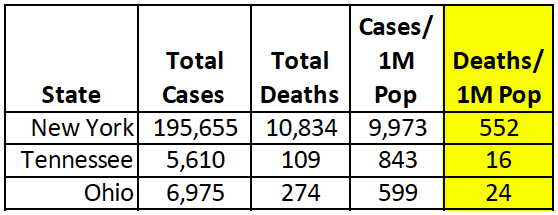As governors across the US gauge when to re-open their states, a common sense reminder: New York City is not Nashville, and Nashville isn’t even the county next to it…in the same state! JD Tucille of Reason made this point in his article almost 3 weeks ago, “One-size-fits-all, top-down policies are poor matches for communities of widely varying density, character, risks, and concerns.”
With so many images and reports coming from NYC, America’s center of all media, it’s easy to forget that most of the country has not witnessed anything close to NYC’s crisis. Combine travel with population density and a lingering winter and cool Spring, and NYC is the perfect place to spread a very contagious and previously undiagnosed disease.
By contrast, many local health systems around the US never had the influx of virus positive patients. Even fewer health systems have been stressed like they were in the 2017-2018 flu season which saw an estimated 21,000,000 medical visits, 810,000 hospitalizations and 61,000 deaths. In fact, in some parts of the US, emergency plans have even been cancelled completely because they didn’t see a single patient.
NYC is definitely a very densely populated, internationally travelled city. But that’s not the only thing that makes NYC uniquely problematic for a viral outbreak. NYC is in the bottom 1/4th of ICU beds per capita for US metropolitan areas. In fact, according to The Washington Post and a study by Columbia University Professor Adam Sacarny, NYC ranks No. 220 on a list of 305 US hospital regions for ICU beds per capita. Unfortunately, NYC’s conditions ended up being the perfect storm.
But the vast majority of the country does not have NYC’s international travel, population density or lack of ICU beds per capita, so the virus isn’t hitting most communities near as hard. As an example, let’s look at the US stats with and without the state of New York as of noon EST April 14, 2020:
US Totals with New York: 591,064 total cases, 24,600 total deaths
US Totals without New York: 395,409 total cases, 13,766 total deaths
That’s nearly a 40% reduction in cases and a 56% reduction in total deaths nationwide – just by removing New York state from the data. Crazy!
Here is a more detailed comparison between New York and my old state of Ohio and my new state of Tennessee.

You can see the significant differences in just these states. What factors into these differences? Demographics of the population (age, health, etc), population density, travel/commute, weather, etc, etc. Bottom line, every US state and region is different, and even individual counties within those states are different.
Governors of each state need to end the one size fits all lockdowns, and then start looking at their local needs, down to the county and city level. And even more than that, the activity recommendations should focus on the most at risk populations, NOT the general population as a whole. In nearly every state and study, it’s clear that older populations are at highest risk, along with those who have compromised immune systems or multiple underlying health conditions.
With this information in wide circulation, do you think anyone in a high risk group is clamoring to hang out in large groups or crowded places? Do you think families want to expose their at-risk loved ones to potential danger? Of course not.
Serious precautions should be advised and personally undertaken by those in high risk groups. I’d love to see crowded businesses and venues voluntarily start making special accommodations as grocery stores and others have made for those in high risk groups. Let’s praise those businesses and hold them up for such proactive choices. But let’s also make good decisions based on data and self-responsibility, not one size fits all decision making rooted in fear.
